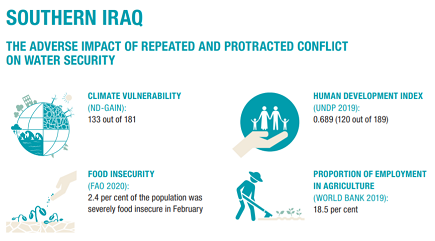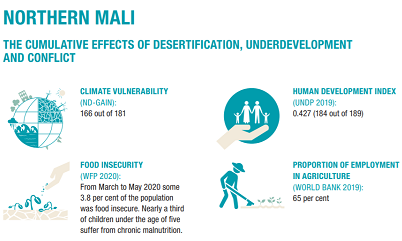This report was first published on 9 July 2020 by the International Committee of the Red Cross (ICRC).
Climate disruption affects populations across the globe and will do so increasingly. Growing climate risks threaten lives, physical and mental health, and food and economic security. They also exacerbate existing vulnerabilities and inequalities. Countries in situations of armed conflict are disproportionately affected by climate variability and extremes. This is in part because of their geographical location, but mostly because conflicts and their consequences limit the adaptive capacity of people, systems and institutions.
Based on research conducted in the interior of the Central African Republic (CAR), southern Iraq and northern Mali, and drawing on the expertise of the International Committee of the Red Cross (ICRC) and the scientific literature on the topic, this policy report explores how people experience the combined consequences of armed conflict and climate risks, and how they cope and adapt. It also discusses how the ICRC, and the humanitarian sector in general, must adjust and adapt to address these risks, and calls for strengthening climate action in conflict settings.


ICRC CALL
Major global efforts must be made to limit climate change. They are an absolute necessity for averting the most disastrous consequences for people and their environment. But such efforts will only limit, not halt, the climate crisis. They must be complemented by measures to help people and communities adapt to a changing climate and environment. People affected by conflict are among those most vulnerable to the climate crisis, but they are also among those most neglected by climate action. We must work together across the International Red Cross and Red Crescent Movement, the humanitarian sector and beyond to reverse this trend.
Humanitarian organizations must commit sufficient resources and expertise, and provide the leadership necessary, to:
SKILL UP to respond adequately to the vulnerabilities and needs resulting from the intersection of conflict and climate risks.
TEAM UP across the International Red Cross and Red Crescent Movement, the humanitarian sector and beyond to strengthen climate action during armed conflict and to ensure that people already suffering the consequences of war are not left out.
ANTICIPATE RISKS AND STRENGTHEN RESILIENCE, in order to protect communities by promoting respect for the environment during armed conflict and by designing programmes that help people develop resilient livelihoods and shelters, reinforce access to hazard-resilient essential services, and ensure that populations are adequately informed of risks and adaptation pathways.
MOBILIZE FOR IMPROVED CLIMATE ACTION AND FINANCE so that climate action reaches places in crisis and funding is more equitably balanced between mitigation and adaptation efforts.
LEAD BY EXAMPLE, by limiting the damage we cause to the environment and the climate and by ensuring the resilience of our operations to extreme weather events.
Read the full report here.
Photocredit: IDMC NRC/ Flickr



